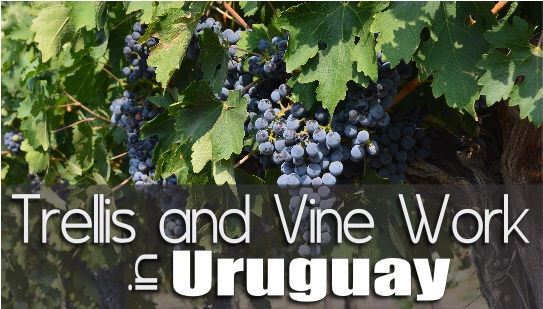
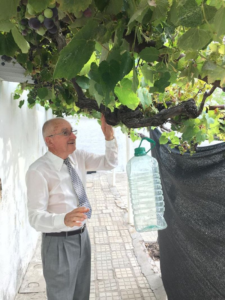
I had been waiting for the knock on the door of the casita (little house) for a couple of days. After attending the EMU Worker’s Retreat and Family camp for the past three years, I had come to expect a visit from Pastor Jose Kowalczuk. This strong and vocal leader is one of the nicest men I have ever met. The spry, 76-year-old widower pastors Calvary Temple of Durazno in the Interior of Uruguay.
Though Jose lives and serves in a town named “Peach” in Spanish, it is another fruit that has me waiting in anticipation for his visit each year. When I visited with Jose last year and preached in his church, I walked out back and saw grape vines that could only be rivaled by those encountered by the Israelite spies in the Valley of Eschol. Each year Pastor Jose brings small bottles of grape juice to the EMU missionaries. Muy dulce is the Spanish expression for very sweet, and that describes the juice and also Pastor Jose. You don’t guzzle this oh so delicioso taste of the Promised Land. It contains enough sugar to send the Cookie Monster into a diabetic coma.
My companions for the annual trip to Uruguay this year were my friends Steve and Karen Ridge. (We have known each other for thirty years.) Steve serves on the board of directors for EMU International and is the Executive Pastor at the Grace Bible Church in Colorado Springs. The theme of the camps this year was “The Church and You.” Our task for the two weeks we were there was to magnify the mission that God has given us to make disciples through the institution of the local church. Steve had nine specific speaking opportunities during our Workers’ Retreat and five sessions during Family Camp. Karen, an excellent speaker herself, was given an opportunity to speak to the ladies during Family Camp. In addition to the personal interviews I held with each of our missionaries, I was privileged to preach four evenings of Family Camp and seven times in the churches on the weekends. Steve has used his gift of discipleship in each church ministry he has served. I honestly don’t know if we could have chosen a more appropriate speaker for the subject matter this year.
 In their excellent book, The Trellis and the Vine, Colin Marshall and Tony Payne use the metaphor of a backyard garden to teach us about discipleship. Trellis work represents the necessary structures of ministry. Vine work represents discipleship, the ultimate purpose of the Great Commission. They write, “Trellis work often looks more impressive than vine work. It’s more visible and structural. We can point to something tangible–a committee, an event, a program, a budget, an infrastructure–and say that we have achieved something. We can build our trellis till it reaches to the heavens, in the hope of making a name for ourselves, but there may still be very little growth in the vine. Our goal is to grow the vine, not the trellis.”
In their excellent book, The Trellis and the Vine, Colin Marshall and Tony Payne use the metaphor of a backyard garden to teach us about discipleship. Trellis work represents the necessary structures of ministry. Vine work represents discipleship, the ultimate purpose of the Great Commission. They write, “Trellis work often looks more impressive than vine work. It’s more visible and structural. We can point to something tangible–a committee, an event, a program, a budget, an infrastructure–and say that we have achieved something. We can build our trellis till it reaches to the heavens, in the hope of making a name for ourselves, but there may still be very little growth in the vine. Our goal is to grow the vine, not the trellis.”
As I travel to Uruguay each year, I find it necessary to spend some time on trellis work – buildings, budgets, board meetings, etc. But our focus is people, vine work. From gospel seeds planted in Uruguay seventy-three years ago, EMU International continues to bring forth fruit through the focused efforts of our missionaries to evangelize, establish churches, and equip nationals. It is my goal in this article to update you on many of these people.
After an all-night flight from Miami, we arrived in Uruguay on Saturday morning, February 23, to unseasonably mild temperatures. It was the end of summer in the Southern hemisphere, equivalent to August 23 for us. Out of curiosity, I calculated the latitude of the EMU Mission House in Montevideo, the capital city, 34.889926 South, and wondered if Greenville was anywhere near the same distance from the equator. I was surprised to find that 34.889926 North puts you right in the center of the Greenville-Spartanburg International Airport.

We arrived at Camp Emmanuel in time for lunch. Carlos Alberti was manning the grill and delivered on my promise to the Ridges that they would not be disappointed in the food. With a population of 3.4 million people and 14 million head of cattle, Uruguay boasts the highest cattle per capita rate in the world. They also rank number one in beef consumption per capita with each Uruguayan consuming over 124 pounds of beef every year. Thanks to Carlos’s amazing grill skills, Steve and I did our part to add to the consumption numbers. Karen and Carlos’s wife, Beatriz, were a little more careful about how much they ate. We walked around the camp and admired the work of Rick Jensen’s team back in October – the newly constructed deck for the game pavilion, the new cabin doors, the 7 new firehose stations, and the amazing tree work.
On Sunday, Pedro Donzé drove us to Calvary Temple in Montevideo where Steve shared a brief testimony and I preached. As usual, Chicha Rodriguez served as my interpreter. The church is pastored by Gustavo de Oliveira. This is a growing church of about 130 people. This has been a year of trials and blessings for them. My message was an effort to encourage the congregation to trust God this day. They have a heart for missions. Last year they were involved in church planting efforts in Artigas, about 8 hours to the north. This year they have eight couples who are helping with a church on the outskirts of Montevideo.
This is also the home church of several of our single lady missionaries. I was encouraged to visit with Marianne Rauter. For many years, she has served as the main translator of our Uruguayan correspondence. A few months ago, she fell and is still having a hard time getting around. She was not able to attend camp this year. After church, I showed the Ridges the EMU Mission house. John Mark and Deborah Steel, who live in this house, were in the United States at the time. Julia Piedad began working with EMU in 1950 as the housekeeper of the Mission House and Office. She still lives there. She celebrated her 93rd birthday on February 16.
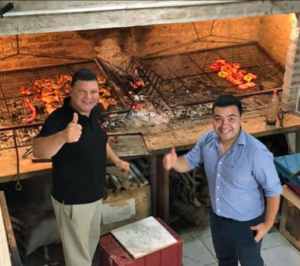
 For lunch we enjoyed chicken and chorizos (pork sausage), stuffed with cheese, cooked on the new grill that Calvary Temple built this past year. They also have a new roof over the fellowship hall. Several of the deacons and their families stayed and joined the pastor and his family as we all celebrated Ursula Thiessen’s 91st birthday. This past year she moved to live with her sister, which is next to her niece’s family. A nice family that lives nearby gives her a ride to church each Sunday. She is still faithfully serving God and was able to attend both weeks of camp.
For lunch we enjoyed chicken and chorizos (pork sausage), stuffed with cheese, cooked on the new grill that Calvary Temple built this past year. They also have a new roof over the fellowship hall. Several of the deacons and their families stayed and joined the pastor and his family as we all celebrated Ursula Thiessen’s 91st birthday. This past year she moved to live with her sister, which is next to her niece’s family. A nice family that lives nearby gives her a ride to church each Sunday. She is still faithfully serving God and was able to attend both weeks of camp.
After a brief rest in the afternoon, Chicha drove the Ridges, Ursula, and me to Fortaleza del Cerro, the last fort constructed by the Spanish in Uruguay, completed in 1839. It is situated on the highest hill overlooking Montevideo, 440 feet above sea-level on the opposite side of the Bay of Montevideo. It houses a military museum and honors José Gervasio Artigas Arnal (1764-1850), known as “the father of Uruguayan nationhood.”

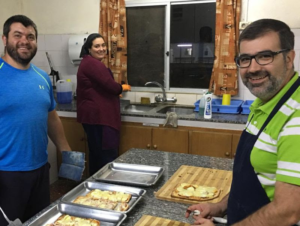
On Sunday evening we attended Emmanuel Church in El Cerro, pastored by Ovidio Acevedo. Steve shared his testimony and I preached on “Foundations,” a look at the wise and foolish builders in Matthew 7. Following the service, the church had a sweet time of fellowship, and we honored Ursula for her birthday. Chicha then took us to Gethsemani Church, pastored by Gaby Gomez, where we visited with some of the church families and then met Pedro, who took us back to camp. After a late supper of Uruguayan pizza, we were ready for our beds. We needed rest for the approaching busy week of Workers’ Conference.
It is always a joy to see our missionaries arriving at Camp Emmanuel for the Workers’ Conference. This week is a great time to catch up with ministry friends and encourage one another. Much time is spent in prayer and discussion over the Word of God. To hear the Uruguayans sing is also such a blessing. Nico Gomez, who organizes the meals for the camps, broke away from his kitchen duties to play the guitar as Pedro led the music. The preaching times are an added blessing.
Steve spoke on the subjects of 1) Expository Preaching, 2) Biblical Theology, 3) The Gospel, 4) Salvation, 5) Evangelism, 6) Church Membership, 7) Church Discipline, 8) Discipleship, and 9) Church Leadership. I held the bulk of our missionary interviews that week. I also shared a Director’s Update. Our Uruguayan missionaries loved hearing about what God is doing through our EMU missionaries around the world. Several asked for the PowerPoint presentation so they can show it to their church families.

I want to give a major shout out to Matias Espinel who served as the main translator for Steve and me. As director of F.E.B.U. (Bible college), he was busy making plans for the new semester, which began the week after Family Camp, but he attended and worked for us at both weeks of camp. It was special for Steve and Karen to spend time with Matias and Kristine as they know each other from a previous ministry. The kids especially loved having Karen with them as they thought she was a third grandmother for them.
On Friday, Chicha drove the Ridges and me to visit the small resort town of Piriapolis where we enjoyed a breathtaking panoramic view of the coastline. I also introduced them to Uruguay’s national dish, the chivito al plato. It is made with a beef steak, 2 or 3 slices of bacon, an egg, ham, mozzarella, tomato, onion, lettuce, fries, and Russian potato salad. Steve and I split the platter and still couldn’t finish it. Chicha and Karen split a salad. On the way out of town, we had to stop for ice cream. I imagine Karen and Chicha had salad to save room.

I told the Ridges earlier that we were going to spend the second weekend in the Interior. I guess I wasn’t clear enough about what they should expect because Steve went out and got shots in preparation for this rugged trip. I will confess that when I first heard about the Interior of Uruguay, I also had pictures of David Livingstone and his machete cutting a path through the jungles. The trip isn’t rugged in any way, other than the occasional pothole we had to dodge. The roads are actually quite nice through the rolling hills of the Uruguayan countryside. We saw windmills, which power nearly 34% of Uruguay’s electrical grid. We also saw a lot of cattle and an occasional gaucho, the Uruguayan cowboy.
We stopped about half-way to our destination in a small town called Minas. On the east side of the city, we drove up another small mountain (919 feet high) called Cerro Artigas, which offers a panoramic view of the city and surrounding area. At the top there is also a small park and a statue of José Artigas, Uruguay’s founding father, sitting atop a horse. (You can also find statues of Artigas on Virginia Avenue and Constitution Avenue in Washington D.C., and on 6th Avenue and Spring Street Park in New York City.)
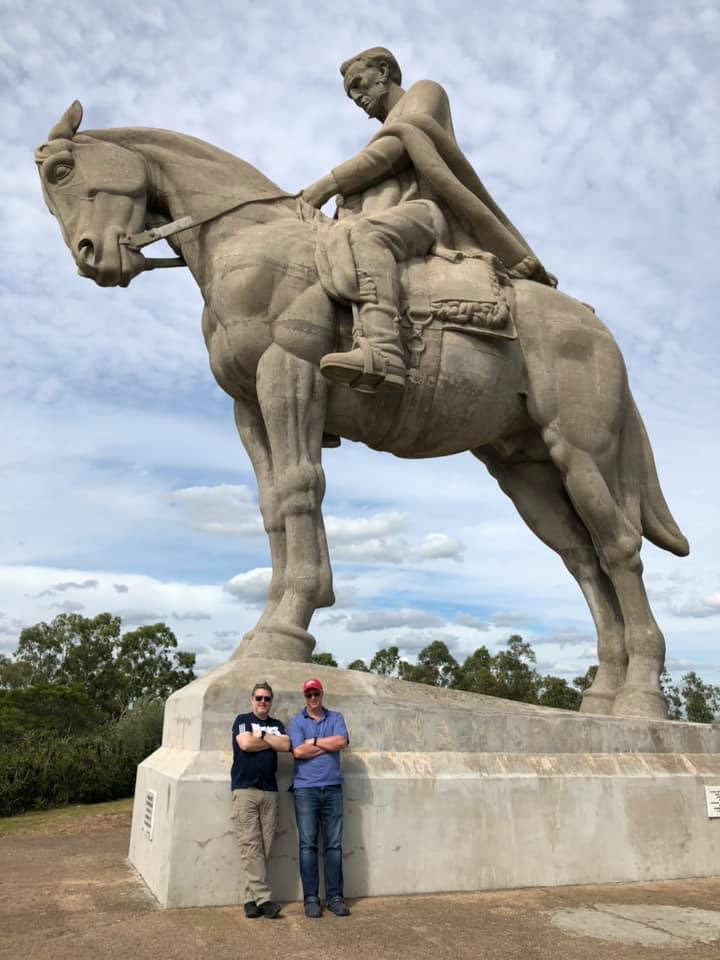
We then made our way to Treinta y Tres where we met Pastor Rubito Rodriguez and his wife Marita. He wanted to show us the progress on his new house, so we followed him out of town a couple of miles to see how he and his family have been spending their Mondays for the past year. He is building the house himself. There are several church members who live close. Currently, they live in a small house above the church. We went back to the church where we enjoyed a delicious meal together. Rubito is Chicha’s nephew, so we had an opportunity to hear a lot of great stories. Following the meal, while the girls visited together, the guys watched soccer highlights. The family gave up their bedrooms so we could spend the night at their house. They slept on mattresses in the church sanctuary.
Saturday morning, after a nice breakfast, we drove out into the countryside to visit the house where Chicha grew up. That house has been converted into a camp, called Camp Bethel. It is much more rustic than Camp Emmanuel, but it gets used regularly, and the people in that area love attending. I last visited a couple of years ago and was impressed to see the improvements that they have made. The camp is maintained by the people of Calvary Temple in Treinta y Tres.
From the camp, we traveled a short distance to the small river town of La Charqueada. This is the home of another one of our single missionaries, Julia Alvarez. With her motorcycle, she visits the neighboring villages and spreads the gospel door-to-door, which sometimes is a mile between houses. She serves in a small church, and the new sign out front reads Iglesia Bautista Jesus es el Camino (Jesus is the Way Baptist Church). This past year they put in new floors and improved the bathroom. Julia oversees the ladies’ meetings at Camp Bethel. She also served us an amazing lunch. While the ladies cleaned up after the meal, Steve found his way to her hammock where he enjoyed a brief power nap.
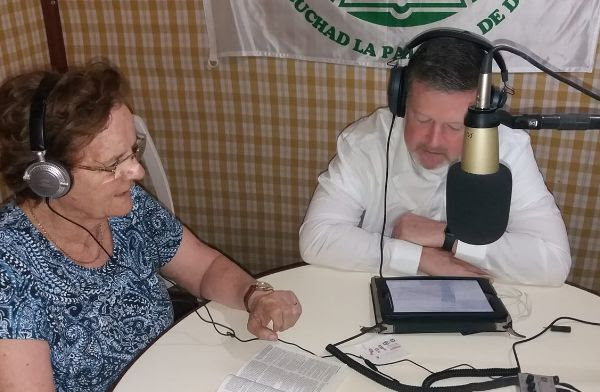
We then traveled to Vergara, another small town, where we stopped at a radio station called the Liberator. This is also the home of Ricardo and Mayka Windmoller. The building has several bedrooms and houses a Christian radio station. We enjoyed a brief time of fellowship and then had to leave for a service that Ricardo had planned for his church that Saturday evening. I was surprised to find a large crowd gathered for the special service. There was such a sweet spirit and enthusiastic singing that it was really easy for me to preach. Following the service, we enjoyed a fellowship time with typical Uruguayan pastries. It had been a busy weekend for us already, so we rested well that night
On Sunday morning, Chicha and I were up early for a half-hour radio broadcast. I preached on the subject, “You Must be Born Again.” Ricardo manned the controls. In addition to those listening in Uruguay, he was excited to have people tuning in from across South America, North America, and Europe.
Mayka made omelets for breakfast and then we returned to church for Sunday worship. The children took the stage and sang several songs. I preached again, this time on Matthew 9, “Moved with Compassion.” The text doesn’t say that Jesus was moved with commitment. It is sometimes easier to be committed than compassionate. Most of our churches, including this one, have visited their towns and gone door-to-door many times. I told them not to neglect their efforts to visit every house but to also develop a more relational approach. Why not just walk next door and sip máte (Uruguayan green tea) with their neighbors and build relationships with a goal of presenting the gospel? This church responded favorably to that suggestion.
Following the service, the children walked down the aisle, each one grinning ear-to-ear, with those in front carrying a birthday cake. They were singing Happy Birthday in Spanish to Chicha. I’m not going to tell you how old she is, but I will tell you that God has given her amazing stamina to do as much as she does. She has a radio ministry that reaches throughout South America. She ministers in the hospitals and jails, along with leading women’s ministries. During the camp season, she is one of the main translators for any visiting English speakers. And she serves on the mission’s Uruguay Board of Directors.
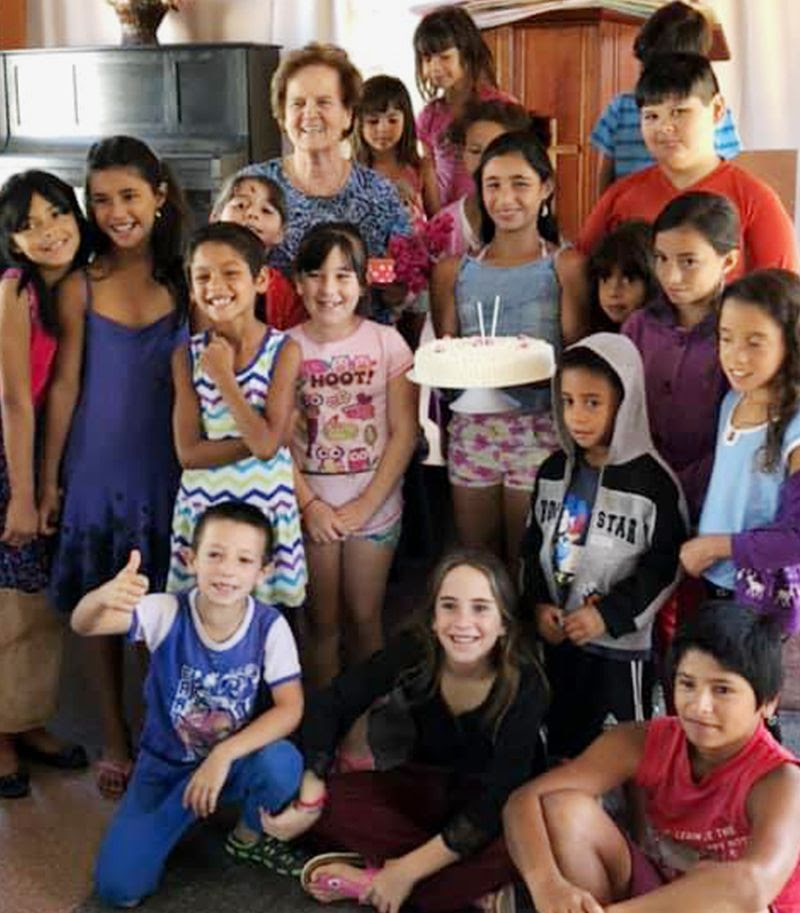
After a delicious lunch with the Windmollers, we rested a little and then drove back to Calvary Temple in Treinta y Tres. That evening I preached twice. The first service was a sweet time as we celebrated the Lord’s Supper together. In the second service, the church was packed into an overflow room on the backside of the auditorium. The music is always special at this church. It was a joy to preach again for these people as this was my third visit to the church. Following the service, we enjoyed a quick piece of birthday cake and then drove the four hours back to camp, arriving just before 1 am.
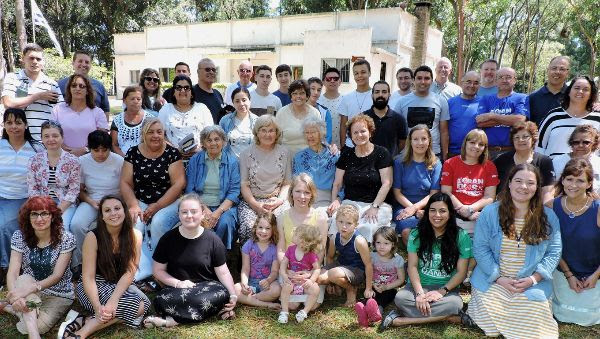
The second week of camp was a typical week of Family Camp. The temperatures had risen, approaching the 90’s. The people were very receptive to the preaching of the Word, Steve in the mornings and me in the evenings.
Family Camp also affords the opportunity for friendly competition. On Thursday, we had a race around the camp, and I carried the Uruguayan flag, deliberately finishing in last place. The teenagers then wanted to take one more lap around the camp and encouraged me to join them. When the signal was given, I took off, sprinting ahead of all the teens. After about 40 yards, I decided I didn’t want to wear myself out, so I started to slow down. At that moment, I felt a ping in my hamstring. I forgot again, yes, I have done this before. I spent the next couple of days icing and wrapping my pulled hamstring muscle.
One of the blessings of having guest speakers visit Uruguay is to see them interacting with the nationals. Neither Steve nor Karen speak Spanish, but both made efforts to get to know the different campers – life on life, relational disciple-making, even across language barriers. The Trellis and the Vine describes vine work as “. . . the basic agenda for all disciples. To be a disciple is to be a disciple-maker.”
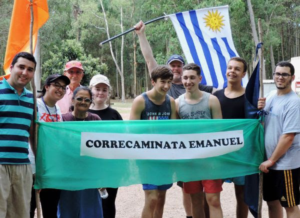
We left Uruguay on Friday evening with hearts full of praise to God for a wonderful two weeks spent together. Karen mentioned that God had knit their hearts with the people of Uruguay. Steve described how this trip gave him a new perspective on how to pray for his new friends.
According to the Farmer’s Almanac, now is the time for me to start planning my garden. As I plant and water, may I be reminded of the work that God is doing through our EMU missionaries serving in Uruguay and all around the world. It is easy for those of us in administrative roles to find ourselves focusing on trellis work. We need to be like Pastor Jose who tends his grape vines. It is our prayer that as we tend to the trellises and the vines, God will give the increase. We also appreciate the watering of your prayers for the ministries of EMU. †